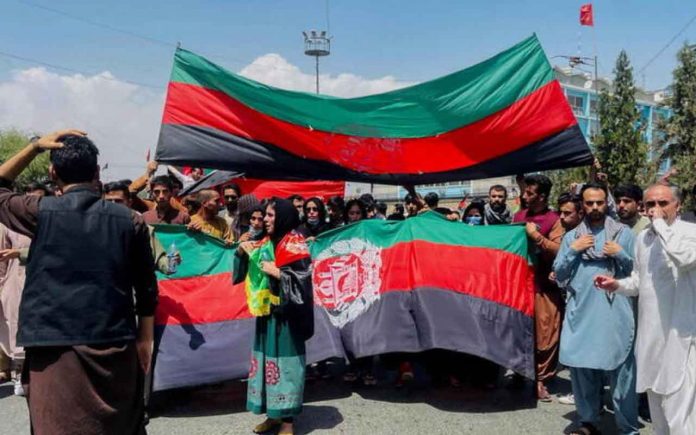Journalist Zahra Joya was forced to flee Afghanistan but continues to run her news agency from a London hotel
* Feminist Zahra Joya lived as boy to flout education ban
* Joya vows to keep media spotlight on Taliban
* Most women still barred from work, she says
By Emma Batha
LONDON – TECH – (Thomson Reuters Foundation) – When the Taliban last ruled Afghanistan, Zahra Joya dressed as a boy and called herself Mohammad, allowing her to circumvent the Islamist group’s ban on girls going to school.
The journalist’s unusual childhood not only let her get an education, but gave her a taste of the freedoms denied to most girls in Afghanistan, where many families only celebrate the birth of sons.
An outspoken feminist, Joya set up Rukhshana Media last year – a news service reporting on Afghan women’s lives, including the economic hardship and violence many endure.
Joya, 29, is among hundreds of journalists who have fled the country since the Islamist militants’ shock return to power on Aug. 15.
Today she is living in a London hotel – a stone’s throw from the Tower of London – after being evacuated from Kabul following the Taliban’s takeover.
From her room she continues to report on events 5,800 km (3,600 miles) away, relying on six women journalists working covertly, and her network of contacts.
“Our work is now more important than ever because most media have closed,” she said, adding that more than 150 outlets in the country’s once vibrant media sector had shut since August, and most women journalists had stopped working.
“Afghanistan is the only country where half the population don’t have basic rights. It’s crucial we show what’s happening,” said Joya, who will address the Thomson Reuters Foundation’s annual event, Trust Conference, on Thursday.
When the Taliban last ruled from 1996 to 2001, they barred women from work and imposed harsh restrictions on their lives, flogging or stoning those who broke the rules.
This time they have said girls and women will be allowed to study and work in accordance with Islamic law, without clarifying exactly what this means. Most women and high school girls remain at home.
SOCIAL MEDIA
Joya said technology and social media were helping journalists monitor the Taliban in a way that was not possible when the Islamists last ruled.
But she said extremists were also using social media to spread propaganda and incite hatred.
Joya is from the predominantly Shi’ite Hazara community, who have long been targeted by militants including the Taliban and Islamic State.
“I’m a woman, a journalist and a Hazara – three things the Taliban don’t like,” she said.

Joya started Rukhshana Media last year with her own savings to give Afghan women journalists a platform to discuss issues neglected by the mainstream media including sexual harassment, child marriage and economic empowerment.
“Male journalists decide what’s newsworthy in Afghanistan,” she said. “They don’t understand the value of telling women’s stories. For example, they report on rape, but don’t discuss the repercussions for survivors.”
In August, Joya launched a $20,000 appeal to keep Rukhshana going. Within weeks $300,000 in donations had poured in from around the world.
She has since set up an English language service and plans to hire more reporters across Afghanistan.
“I was overwhelmed by the response,” she said. “It’s a huge responsibility to repay the trust of all these people.”
Rukhshana Media is named after a young woman who was stoned to death in 2015 after fleeing forced marriage.
Joya said her fate illustrated the misogynistic violence and inequality that permeates society.
GROWING UP A BOY
When Joya was born in Bamyan province in central Afghanistan her grandfather wept because she was not a boy.
“This is a big subject for Afghan feminists,” she said. “Nobody celebrates girls. It’s hard to know that when you were born you didn’t have any value. It’s like a wound that never heals.”
Flicking through photos on her iPhone showing the brilliant blue lakes and craggy brown peaks of her home region, Joya described a childhood running in the mountains and playing football with her classmates.
She laughed as she recalled their bewilderment when, aged about 13, she first turned up at school dressed as a girl. Reluctant to abandon her previous identity, she became Mohammad Zahra – a name some relatives still use.
After studying law at university, Joya tried a stint in a newsroom and was instantly hooked.
Her father, a prosecutor, had wanted her to become a judge, believing journalism was too dangerous for a woman in Afghanistan, but is now immensely proud of her.
Joya left Kabul on Aug. 25 with four siblings and her niece amid an international operation to evacuate tens of thousands of people deemed at risk of Taliban reprisals.
After boarding the plane, Joya searched for a window seat for a last glimpse of her homeland. But it was a military plane. There were no windows.
“I couldn’t even say good-bye,” she said, wiping away tears.
Joya only packed some clothes and her computer in her rucksack.
“My computer is my weapon,” she said. “With my computer I’ll continue to … stand up against the Taliban.”
When she feels overcome by the harrowing stories that consume her day, she takes comfort playing with her one-year-old niece Ellaha.
“I’m very happy she’s growing up in a country that knows the value of girls,” Joya said.
(Reporting by Emma Batha @emmabatha; Editing by Katy Migiro. Please credit the Thomson Reuters Foundation,

